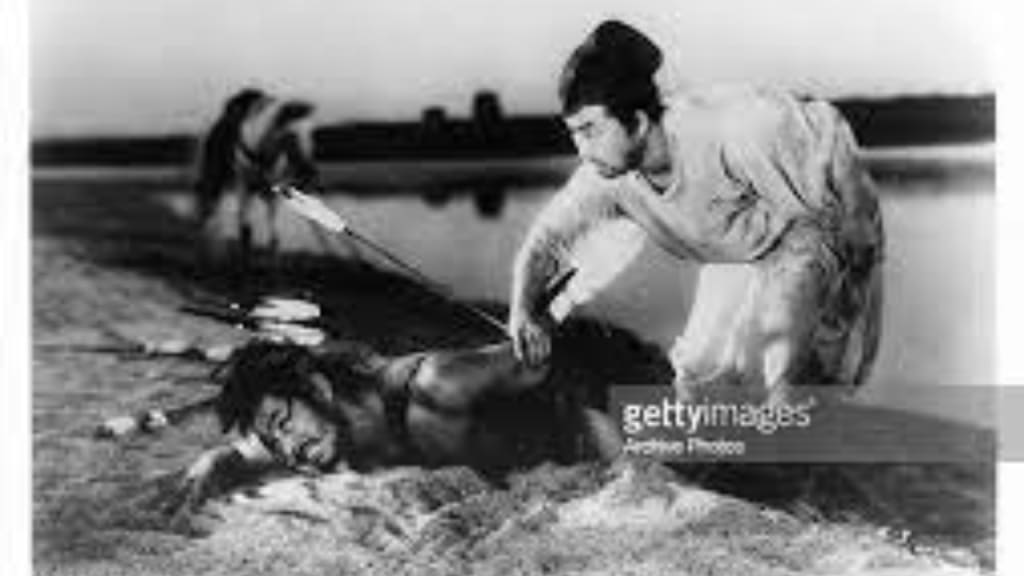Rashomon (1950) Review
1950 Jidaigeki psychological thriller-crime film directed and written by Akira Kurosawa

Akira Kurosawa's "Rashomon" is a groundbreaking film that challenges conventional notions of truth and reality. Released in 1950, the film tells the story of a murder and rape from multiple perspectives, each of which contradicts the others. With its non-linear structure, subjective viewpoints, and philosophical themes, "Rashomon" is a film that continues to captivate audiences and inspire filmmakers today.
Plot:
The film takes place in feudal Japan, where a man named Takehiro and his wife, Masago, are traveling through a forest when they are accosted by a notorious bandit, Tajomaru. The bandit ties up Takehiro and proceeds to rape Masago. The events that follow are told from the perspective of four different characters: Tajomaru, Takehiro, Masago, and a witness to the crime, a woodcutter.
As each character tells their version of events, the truth becomes increasingly elusive. Tajomaru claims that he killed Takehiro in a fair fight, while Masago claims that she killed her husband out of shame and despair. Takehiro's version of events, as revealed through a medium, is the most ambiguous and enigmatic of all. The woodcutter, who initially claims to have only seen the aftermath of the crime, eventually admits to having seen more than he let on.
Themes:
At its core, "Rashomon" is a film about the subjectivity of truth. Each character's version of events is colored by their own perceptions, biases, and desires, making it impossible to discern a single objective truth. The film suggests that the truth is not a fixed, objective entity but rather a fluid and subjective one that is constantly being reinterpreted and rewritten.
The film also explores themes of human nature, morality, and the nature of existence. The characters in the film are all flawed and imperfect, capable of both great good and great evil. The film suggests that human nature is inherently ambiguous and complex, and that morality is not always clear-cut.
Cinematography:
Kurosawa's use of the camera in "Rashomon" is innovative and visually stunning. The film features several long takes and dynamic tracking shots that create a sense of movement and fluidity. The use of close-ups and extreme close-ups on the characters' faces helps to convey their emotions and inner turmoil.
The film also makes extensive use of natural light, with the scenes in the forest filmed in a way that captures the changing light and shadows. The film's use of rain and mist adds to the sense of ambiguity and uncertainty that pervades the story.
Acting:
The film's cast, which includes Toshiro Mifune as Tajomaru, Masayuki Mori as Takehiro, and Machiko Kyō as Masago, delivers exceptional performances. Mifune's portrayal of the bandit is particularly noteworthy, with his energetic and charismatic performance adding a sense of vitality and danger to the character.
Kyō's performance as Masago is also exceptional, with her ability to convey a range of emotions and conflicting desires adding depth and complexity to the character. Mori's portrayal of Takehiro is more subdued but equally effective, with his stoic and enigmatic performance leaving the audience unsure of his true intentions and motivations.
Legacy:
"Rashomon" is a film that has had a profound influence on the art of cinema. Its non-linear structure and use of multiple perspectives have been emulated and adapted by countless filmmakers since its release, including Quentin Tarantino, Martin Scorsese, and Christopher Nolan. The film's themes of truth and subjectivity continue to resonate with audiences today, making it a timeless classic of world cinema.
Conclusion:
Akira Kurosawa's "Rashomon" is a groundbreaking film that challenges conventional notions of truth and reality. With its non-linear structure, subjective viewpoints, and philosophical themes, it remains one of the most important and influential films in the history of cinema.
The film's exploration of the subjectivity of truth is particularly relevant in today's world, where the concept of truth is often challenged and disputed. The film suggests that the truth is not always a fixed and objective entity, but rather a subjective and fluid one that is constantly being reinterpreted and rewritten.
The film's use of innovative cinematography techniques, including dynamic tracking shots and natural light, adds to the sense of ambiguity and uncertainty that pervades the story. The exceptional performances by the cast, particularly Toshiro Mifune as the bandit Tajomaru, contribute to the film's impact and lasting legacy.
Overall, "Rashomon" is a cinematic masterpiece that continues to captivate audiences and inspire filmmakers today. Its exploration of the subjectivity of truth, complex characters, and innovative filmmaking techniques make it a must-see for anyone interested in the art of cinema.
About the Creator
Enjoyed the story? Support the Creator.
Subscribe for free to receive all their stories in your feed. You could also pledge your support or give them a one-off tip, letting them know you appreciate their work.





Comments
There are no comments for this story
Be the first to respond and start the conversation.